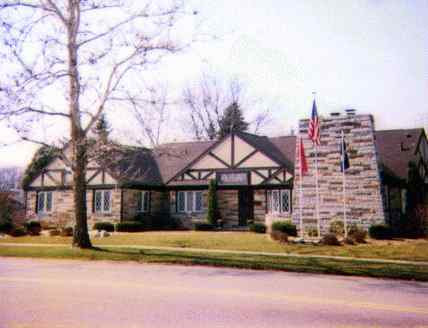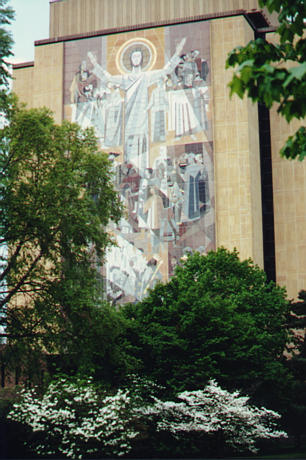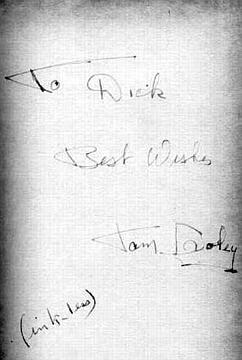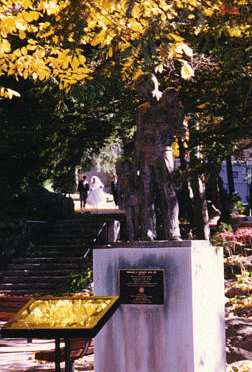
Dooley and the House with Three Flags
One day, I went to the Grotto to examine Dooley's letter more closely, impressed by its durability and how well its container had weathered the 30 years it had been there. The letter was written on an Italic script typewriter which gives it an especially personal touch. I wondered who had engineered its placement there for Fr. Hesburgh.
It was a balmy summer day, too nice to go inside just yet. I decided to see if there were any ducks in the reflector pool and check out the progress of the men refurbishing the Hesburgh Library mural before returning to the University Archives. I sat down on the wall near a middle aged man and his two young daughters. We were soon engaged in a casual conversation about its progress.
He happened to mention that they had just been to the Grotto and I told him of my particular interest in the Dooley letter. To my surprise, this stranger said, "I know the man who built the box for it." I had made no mention of my interest in the box it was in. I then told him of my research concerning it and he offered this man's name and telephone number. "He's up in years now," he said, "and nearly blind but he might be able to tell you how he did it." I bid them a pleasant day and thanked him for another piece in my Grotto puzzle. He glanced up at the repair of the mural in progress and added with a grin, "or another piece in your Grotto mosaic."

I had a warm telephone visit with the man he mentioned, who was infirm and homebound. Although he spoke of taking a picture of Dooley and Hesburgh in front of the library on his last visit to the campus he could not bring back any details of his part in the box containing the letter.
However, his mention of Hesburgh's name suggested one more alternative left to me -- checking with Father Hesburgh at his office on the 13th floor of the library. His secretary, Melanie, doubted he would remember that far back but she said she'd ask. She came back holding a card with the name and address of the priest he'd turned the project over to, with the added note that it had been placed there four months after Dooley's death.
A weekend call to Fr. Robert Lochner, C.S.C. in Cocoa Beach, Fla. became another Grotto story to add to a growing collection. He was a most affable man, friendly and outgoing and very interested in my project. He told me he had always kept track of Tom Dooley and what he was doing and made many visits to see his mother after his death. That he felt honored that Father Hesburgh had asked him to research a way to put Dooley's letter at the Grotto permanently. He said it made him feel close to Dooley and the Blessed Virgin and more a part of it. That it was his favorite spot to visit on campus and he checks the letter every time he goes there pleased to find that it is still in excellent shape.
He then explained that the letter was engraved on stainless steel because at that time they did the same thing with diplomas which were then placed on a block of wood. The Notre Dame Bookstore made an arrangement for the letter to be engraved in the same manner. Then they had to figure a way to enshrine it permanently so no one would be able to steal it. He said it was framed in Plexiglas for that reason and enclosed in a black metal box. He knew the man I'd talked to, and felt he very well could have been the one who built the box, though the details, he too, was hazy about.
Fr. Lochner's next question caught me by surprise. He asked where I lived. When I told him he said he had a nephew who lived very close to the campus, too, only on the south side. He began to describe the house. He couldn't have known that I had given up learning more about that particular house, almost two years earlier, when a real estate friend told me about it. She viewed the house when it was put up for sale. She remembered being told that it was designed with a Grotto in the basement and there was a missing walled-off first floor room with no flooring to provide the height for a cathedral ceiling in the basement.
A grotto in someone's basement intrigued me, it had to have a story behind it. Unfortunately, at the time I had no success in locating the original owner or anyone who knew anymore about it. It was one of the few times my research had led to what seemed a "dead end."
"I blessed the house when my nephew bought it," Fr. Lochner said. "He has completely renovated it but I haven't seen it since and probably won't until I return for my jubilee." Then as if sparked by an idea, he said, "I want you to be my delegate and see the house for me (I had made no mention of my interest in the house). Just go up to their door, ring the doorbell and tell them I sent you. They are the friendliest people you'll ever meet and great Notre Dame fans. He has three flags on poles in front of the house that are lit at night (the American, Notre Dame, and Marine flags). I assured him I'd get in touch with him and thanked him warmly for the information he had provided. All the time I was thinking, I'll call them, but no way could I see myself walking up to a stranger's door unannounced.
When I followed through on my promise a few days later, I was pleased to find at the other end of the line a man just as affable as his uncle. Dick Lochner, a Notre Dame alumnus and retired Marine Colonel, said he had always wanted to live near Notre Dame. He said he first noticed the house when he brought his daughter from their home in Virginia for her junior year at Notre Dame. The house had been up for sale by a realtor for some time without a buyer. Dick said, he saw what others might have missed that it was structurally sound, and needed only cosmetic improvements. During the next six months he said he made an offer to the realtor but received no replies. In the meantime, Susan, his daughter at Notre Dame noticed a For Sale by Owner sign on the house. She called her mother in Virginia to tell her about it. Her mother called Dick who was out of the country on business and he negotiated the sale with the owner over the phone from Portsmouth, England. He said, to him, the house was the answer to his prayers because his retirement dream was to live in a home close to Notre Dame. One more example of 'a pattern of highly improbable events with a beneficial outcome.'
We had a lovely conversation in which I told him of my interest in the Grotto. He confirmed the early rumors about the house, but could not confirm the story, except that there was a missing 14' x 14' corner room on the first floor at the back of the house that had been walled off from the rest of the first floor. Its interior walls were solid with no openings. The mystery room without a floor formed a cathedral ceiling providing height in the basement, while two windows on each exterior wall (seen only from outside the house) provided the light for what was to have been a Grotto but later became a basketball court.
He knew the man who built the house was a professor at Notre Dame. He did not know his address but had heard he lived somewhere in Florida. Close, but not close enough. As I was about to ring off, he said, "I want you to come over and see my house and bring your real estate friend (Margaret Moore, the wife of a former Ara Parseghian coach). He said, "I'll show you a pastel painting of Dooley, one of his books he autographed to me, and your friend can see the changes I've made in the house since she last saw it.
What more could I have asked for? Almost two years had passed since my conversation with my friend about the house. In updating her on my more recent research and the unusual stories I had encountered she told me an amusing story about her own family's connection to Notre Dame. Something I hadn't been aware of before. She said her father and two uncles all graduated from Notre Dame and the story she had to tell me she'd probably have trouble believing herself if she hadn't found the detailed newspaper stories about her uncle and his adventure in an old trunk to prove it. Gerald Clements, class of 1915, was one of four students who walked to Chicago in 1914 to see Notre Dame play the Carlisle Indians. As loyal Notre Dame supporters they had lost their monthly allowances betting against Yale. So they talked themselves into walking the 102 miles to Comiskey Park. It took them three days. They walked themselves footsore, and her uncle wore out a pair of shoes, but with the help of kind strangers, they made it to Sox Park on 80 cents apiece, surprised to find Mr. Comiskey had box seats waiting for them when they arrived. Notre Dame won 48-6. Gerald Clements' name, along with other ND alumni, who died in WWI, is inscribed at the east door of the Basilica of the Sacred Heart.
Margaret offered me photocopies of the story and, like this one, it has been duly recorded and stored in the Notre Dame Archives. She said she was delighted with the prospect of seeing the house again, that she had heard the new owner had done wonders with it and would love to see his improvements.
I was impressed, and she was amazed at its renovation, how transformed it was and with such good taste. Dick had floored the missing room and brought it to life again. It is now a lovely dining room with arched Tudor style openings to the living room and the kitchen where there were once solid walls. Its exterior windows, beautifully draped now provide a view to the outside. As we parted, he gave us both a refrigerator magnet with a lovely picture of the Notre Dame Grotto on it as a remembrance of our visit to their new home and welcomed us back anytime. We were both charmed by the visit and so pleased to meet him and his wife, Virginia, in person.
When I called him the next day to thank him for taking the time, he gave me the background on his uncle and the Dooley painting and shared his own Grotto remembrance for my collection. "His Uncle, he said, "continued to visit Dooley's mother after his death and often admired the pastel of Dooley in her living room. On one of his visits, he said, feeling her time was near, she told him she wanted him to have the painting. His uncle passed it on to him. The pastel painting, a head and shoulders depiction of Dooley with his arm around a child, is now in his office. It is labeled, Thomas A. Dooley, January 17, 1927 - January 18, 1961, and bears the artist's name, Elizabeth Daniels Baldwin.

The dust cover of the Dooley book, The Night They Burned the Mountain, had a photograph on the front of it like the pastel painting he showed me. The book was autographed by Tom Dooley. Dick explained that he was a student at Notre Dame when Dooley came to the University to receive an honorary doctor of science degree which was presented to him by President Eisenhower who was there to give the commencement address. His uncle was having lunch with Dooley and invited his nephew to join them. Dick said he was reading the book at the time and took it with him hoping Dr. Dooley would autograph it for him. He said Dooley looked the picture of health and there were no indications of the illness that would take his life less than six months later. Dick said the autograph he put in his book showed his upbeat sense of humor. His pen ran out of ink before he could finish it.
The next day I was sharing my visit with Col. Lochner with a new priest friend on campus. "Sure," he said, "I knew Father Lochner, we called him Hollywood Bob because he was often with celebrities on campus, and he had the looks and personality to be in the movies himself."
He also knew about the house I'd seen and the Professor who built it. When I told him it looked like I couldn't confirm the story about the Grotto, because he was no longer in town, he said. "Oh, but he is, I know him and he's retired and living at St. Paul's." He assured me he wouldn't mind my calling and might be pleased to know his house was in good hands. To my amazement the "improbable events" continued unabated.
When several tries brought no answer, I checked with the desk and learned he was away on vacation for several weeks. They gave me an approximate date for his return. My next call found him in. When I explained my call, I felt him smiling over the phone. He said he had just returned from the Lourdes Grotto in France that very day. He confirmed that the story was true, there had been a Grotto in the basement but only for about three weeks when he had a workman come in and remove it after which it was replaced by a basketball court for his four sons. He did not elaborate on why it was removed and I did not feel I should ask. His recent return from Lourdes spoke volumes in that regard.
He said the house was the greatest achievement of his life and he was pleased that it was owned by someone who appreciated it. He said it was built to withstand an earthquake. I told him I knew that, because Dick had shown us the 10" walls in the basement. He offered to supply any information about the house the new owner might need and thanked me for letting him know it was in good hands.
Dick, who had already expressed the wish to show it to the professor who built it, if he knew where to reach him, was delighted to learn I had located a man who was supposed to be unreachable. It led to their meeting and the Professor's comment that every change pleased him and made him feel the house was being loved and cared for.
With Dick's permission I told Becky Emmons, a South Bend Tribune reporter friend -- who did feature articles on interesting Michana homes -- about the house with a story behind it. She did a lovely feature article about it called "In the Shadow of the Dome," shortly afterward.
The inspiration to follow this latest pursuit had certainly turned into a "pattern of highly improbable events with a beneficial outcome" for others besides myself. The outcome may not always be what we had in mind, but invariably, in time, it will wind up being right for us. I was pleased that following my whimsy had not only made them known to one another but it had also unearthed more Grotto related information to add to my research. Including an additional Grotto Remembrance Col. Lochner shared with me.
From little on up Dick said he had always loved Notre Dame and the Grotto. He spent summers there with his uncle when he was growing up and the Grotto had comforted him many times during his college years. It was one of the things that drew him back to the campus in his retirement years. He bought the house at the entrance to Notre Dame because he wanted to be as close to the university as possible. His home even has a Notre Dame Avenue address.
He then told me his favorite memory of the Grotto. While in Vietnam he received a Christmas letter from a young woman. After he wrote to her and she wrote to him -- and sent chocolate chip cookies -- he said he knew he wanted to marry her. When he returned to the states he met her in person for the first time on Thursday, asked her to marry him on Saturday and his uncle married them two weeks later in Cleveland, Ohio. Immediately after the ceremony they packed their car and headed for Morris Inn at Notre Dame. Before they had unpacked their bags he took his new wife to the Grotto (she had never been to Notre Dame) to offer a prayer of thanksgiving that their lives had been joined together.

The thoughts of contemporary writer, M. Scott Peck, M.D., author of The Road Less Traveled and Beyond, whose book I also read by chance, parallel those expressed by Lasserre one hundred and fifteen years earlier:
I am a spiritual person. I know of God not only because of faith, but also on the basis of evidence namely my experiences of grace. . . . One of the most useful ways to establish something scientifically is to apply what are called the statistics of improbability. That means that the lower the mathematically calculated, probability, the greater the improbability, and the safer we feel concluding that an event was not the result of chance alone. Thus, we may conclude that something occurred because of a significant reason, even if it may or may not be explainable. That is why I have commonly spoken about grace in terms of 'a pattern of highly improbable events with a beneficial outcome.' It is also why I have concluded that in such patterns we can see the fingerprints -- if not the actual hand -- of God.
One may attribute these happy happenstances to the intercession of Our Lady -- God answering our prayers -- or simply to what one thinks of as the light of understanding inherent in that inner voice guiding us along life's way. It matters not how they are manifested in our lives, the final results, if they lighten our load and enlighten our way, are little everyday miracles that make life worth living -- for the sweet surprises of the unexpected that await our faith in following them.
The story behind Kathy Turner's unique sketch of the Grotto which follows the House with Three Flags is a third heart warming example.